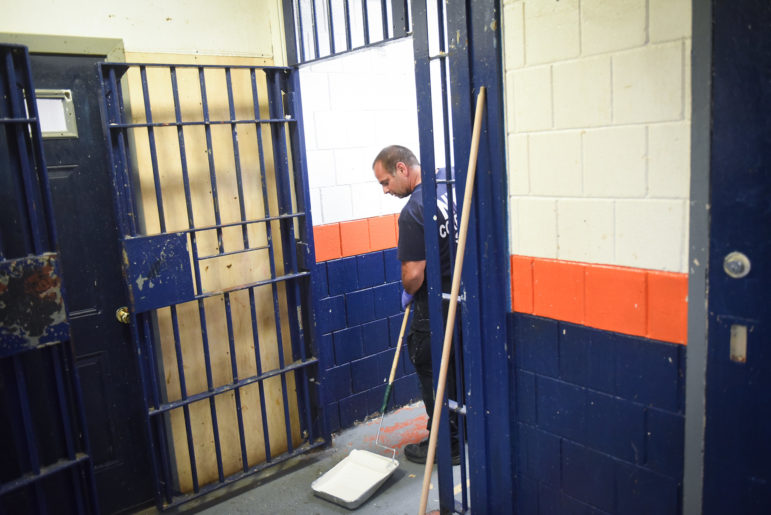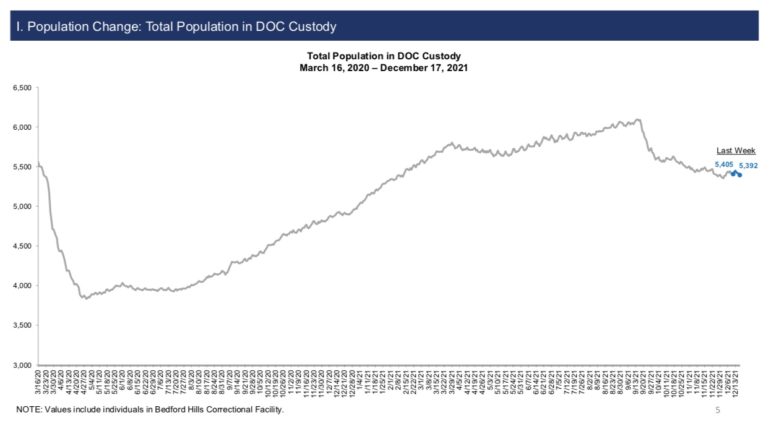
Michael Appleton/Mayoral Photography Office
A staffer paints a cell at Rikers Island in September 2021.In March of 2020, when the coronavirus crisis was first taking root, advocates and attorneys pushed for New York City to lower the number of people in its jail system—concerned about the potential spread of a deadly airborne virus in crowded, shared facilities where social distancing is a long-shot.
In the following weeks, the city’s jail population dropped to historic lows not seen since World War II, officials said: from 5,458 incarcerated people on March 16, 2020, to 3,824 on April 20, 2020.
“We have reached a historic milestone, and done so in a way that is both humanitarian and just,” Mayor Bill de Blasio said in a statement at the time, attributing the decline to a multi-faceted effort on the part of the Department of Correction, district attorneys, judges, public defenders and State parole officials. Hundreds of those serving shorter sentences were released through a supervised furlough program; others being held while awaiting trial, or for small parole violations, were sent home too. Advocates urged the NYPD to halt arrests for low-level offenses, and for judges to rescind bail.
“The overwhelming sense of the time back then was that the default was going to be release, or a much more nominal bail amount,” said Ann H. Mathews, managing director of criminal defense practice at The Bronx Defenders. “And that seemed to be because there was a concerted, shared understanding and recognition of the real dangers posed by, at that point, a largely unknown but potentially lethal virus.”
But the number of people in city jails has crept back up again over the course of the nearly two-year crisis. There were 5,345 people in New York City Department of Correction (DOC) custody as of Thursday, despite skyrocketing COVID-19 infection rates fueled by the omicron variant.

New York City Board of Correction
After a drop in the number of people in DOC custody at the start of the pandemic, the city’s jail population rose again back to pre-pandemic levels. This chart shows numbers from March 16, 2020 – December 17, 2021
The 7-day positivity rate for those in the jail system who’ve been tested for the virus was more than 29 percent on Thursday, compared to 23 percent of city residents overall. But those in custody are much less likely to be vaccinated: just 38.4 percent have received both shots, compared to 72.3 percent of all New Yorkers.
The uptick has renewed calls from experts and advocates for the city to once again lower the number of people behind bars, as it did at the start of the pandemic. The impact of COVID is compounded by deteriorating conditions at Rikers Island over the last several months, which has experienced massive staff shortages and dysfunction, increased incidents of violence and self-harm and where 16 people in custody have died in the last year.
READ MORE: As NYC’s Jail Crisis Worsens, Stable Housing Could Be the Difference Between Rikers and Release
Omicron forced DOC to suspend in-person visits as of Dec. 22, as well as congregate services and other jail programming. The situation is so dire, it prompted DOC Commissioner Vincent Schiraldi to pen a public letter last week imploring judges and other stakeholders to “consider every available option” to release people, saying the “the risks to the human beings in our custody are at a crisis level.”
“As you are aware, considerable efforts were made at the beginning of the pandemic to reduce the jail population immediately in order to avert a major humanitarian catastrophe,” Schiraldi wrote. “All indications suggest that our jail population faces an equal or greater level of risk from COVID now as it did at the start of the pandemic.”
But advocates say they’re seeing little of the same urgency to release people, as there was early on in the crisis. More than 300 people were admitted to city jails in the last two weeks alone; of those currently behind bars, 670 are aged 50 or older, making them more vulnerable to risks of the virus.
“Every week, we’re talking about hundreds of people being newly admitted into DOC custody,” Mathews said.
The overwhelming majority of people in city jails are awaiting trial. In an October report, the Mayor’s Office of Criminal Justice attributed the increasing jail population to an uptick of detainees accused of violent felonies and to “systemic delays” spurred by the COVID crisis, with fewer court appearances and fewer trial hearings leading to lengthier stays behind bars.
“The court system in New York City has continued to not only lag behind pre-COVID levels, but has struggled to rebound as quickly as courts across the rest of New York State,” the report reads.
But advocates say omicron demands the same kind of urgent action that took place at the start of the pandemic to ensure that fewer people are sent to and held in city jails.
“We know it can happen, and we know it can happen quickly,” said Mathews said. “I am hopeful that there will be that same shared recognition now, given that we are in this moment of time where the numbers are just rising rapidly.”










One thought on “Renewed Calls for City to Reduce Jail Population as Omicron Cases Skyrocket”
That’s when Omicron spiked. Now, when the COVID epidemic has subsided quite a lot, what is the situation?